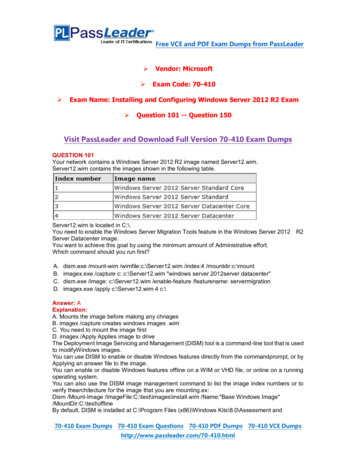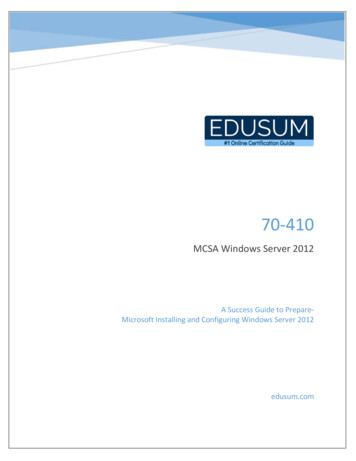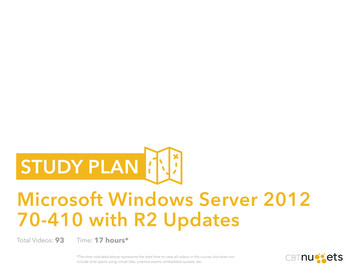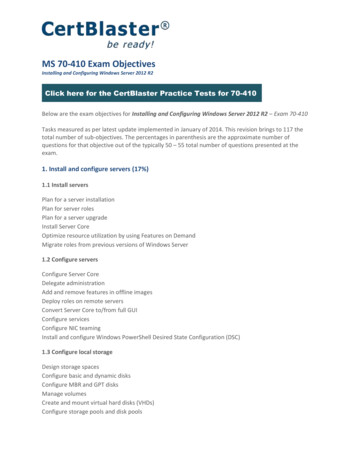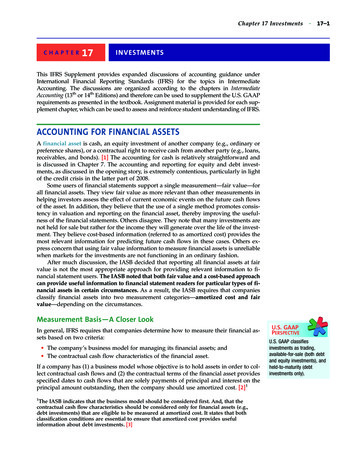
Transcription
University of Illinois at Urbana-ChampaignDepartment of MathematicsASRM 410 Investments and Financial MarketsFall 2018Chapter 1 Introductory Derivatives – Forwards and Futuresby Alfred ChongLearning Objectives:1.1 Derivative Markets: derivative, underlying asset, forward/futures, option,long, short, obligation, exercise, right, regulated exchanges, OTC, hedging,speculation, transaction costs, regulatory arbitrage.1.2 Forward Contracts: forward, underlying asset, expiration date, forwardprice, long, short, position, obligation, spot price, payoff and profit, diagrams,no initial payment, fair forward price, no-arbitrage principle, investment strategy,value process, arbitrage strategy, cash flow, no-cost, arbitrage opportunity,free lunch, no-arbitrage pricing principle, arbitrage-free, law of one-price,buy-low-sell-high argument, replicating portfolio, perfect hedge, forward prices,non-dividend-paying stock, discrete dividends, continuous dividend, syntheticlong/short forward, expected rate of return, expected stock price greater.1.3 Variations on Forwards: purchase method, payment time, asset delivery time,payment amount, outright purchase, spot price, forward contract, forward price,fully leveraged purchase, full loan, prepaid forward contract, prepaid forward price,futures contract, exchange-based forward, mark-to-market, daily settlement,liquidity, offset, opposite position, standardization, credit risk minimized,price limit, temporary halt trigger, margin account, initial margin, notional value,multiplier, earn interest, debit/credit, maintenance margin, margin call, additionaldeposit, close position.Further Exercises:SOA Introductory Derivatives Samples Questions 7, 10, 38, 51, and 52.1
1.1 Derivatives MarketsWhat is a derivative security?1.1.1 A derivative is a financial instrument which has a value determined by the price of anunderlying asset, which could be an equity, an index, a commodity, a currency, or even anotherderivative. Forwards/Futures and options are important examples of derivative contracts.1.1.2 Suppose that Alfred and John enter an agreement that, after one week, Alfred will haveto pay John 70 USD for buying a barrel of crude oil. This is an example of forwards/futureswith the barrel of crude oil as the underlying asset. Consider the following two scenarios. The oil price per barrel falls below 70 USD, say 65 USD. Then Alfred will have to pay 70USD to John, while John will deliver a barrel of crude oil to Alfred. In this case, Alfredexperiences a loss of 5 USD, which is the amount of a gain by John. The oil price per barrel rises above 70 USD, say 75 USD. Then Alfred will have to pay 70USD to John, while John will deliver a barrel of crude oil to Alfred. In this case, Alfredexperiences a gain of 5 USD, which is the amount of a loss by John.Alfred and John are respectively the buyer and the seller of this forward/futures contract. Alfredlongs the contract, while John shorts it. Both Alfred and John bear their obligations oncethe contract is signed.1.1.3 Suppose that Alfred and John enter a different agreement that, after a week, John willchoose to pay Alfred 70 USD for purchasing a barrel of crude oil. This is an example of optionswith the barrel of crude oil as the underlying asset. Consider the same two scenarios. The oil price per barrel falls below 70 USD, say 65 USD. Then John will choose to notexercise the option, while Alfred will not deliver a barrel of crude oil to John. In thiscase, both Alfred and John experience zero gain or loss. The oil price per barrel rises above 70 USD, say 75 USD. Then John will choose toexercise the option and pay 70 USD to Alfred, while Alfred will deliver a barrel of crudeoil to John. In this case, John experiences a gain of 5 USD, which is the amount of a lossby Alfred.Alfred and John are respectively the seller and the buyer of this option contract. Alfred is in ashort position, while John is in a long position. John holds his right of exercising the contractonce it is signed, while Alfred bears his passive obligation to John.Where are derivative securities traded?1.1.4 Derivative contracts are mostly traded in regulated exchanges, such as the ChicagoMercantile Exchange (CME), the Chicago Board Options Exchange (CBOE), and the CBOEFutures Exchange (CFE):2
1.1.5 Derivative contracts can also be traded over-the-counter (OTC), which bypasses theregulated exchanges. Firstly, OTC is easier to trade a large quantity directly between twoparties. Secondly, custom financial claims are available in OTC but not in exchanges. Finally,OTC allows to trade a number of different financial claims at once. The two examples in 1.1.23
and 1.1.3 for forwards/futures and options are OTC.Why are derivative securities traded?1.1.6 Derivatives provide an alternative to a simple sale or purchase the underlying asset, andthus increase the range of possibilities for an investor or manager seeking to accomplish somegoal, which includes the followings. Risk management/Hedging/Insurance: Derivatives are a tool for an individual or acompany to share the risk with another entity. In 1.1.2, if Alfred foresees that a barrel ofcrude oil will be a necessity to him after a week, then such a forward/futures contract withJohn allows Alfred to lock the price at the agreed amount 70 USD. Essentially, a randompayment for the barrel of crude oil is transformed to the constant agreed price. Speculation: Derivatives can serve as investment vehicles. In 1.1.3, if John anticipatesthat the oil price per barrel will increase, then such an option contract with Alfred allowsJohn to make a bet on his belief with a little initial investment. Reduced transaction costs: Sometimes derivatives provide a lower-cost way to undertake a particular financial transaction. Regulatory arbitrage: It is sometimes possible to circumvent regulatory restrictions,taxes, and accounting rules by trading derivatives.Example 1 [SOA Introductory Derivatives Sample Question 24]: Determine which of thefollowing statements is NOT a typical reason for why derivative securities are used to managefinancial risk.(A) Derivatives are used as a means of hedging.(B) Derivatives are used to reduce the likelihood of bankruptcy.(C) Derivatives are used to reduce transaction costs.(D) Derivatives are used to satisfy regulatory, tax, and accounting constraints.(E) Derivatives are used as a form of insurance.Exercise 1: Suppose that Daniel and Klara enter an agreement that, after one year, Klarawill have to deliver Daniel a piece of gold, while Daniel will have to pay Klara 1, 000 USD.Determine which of the following statements is NOT correct.(A) Daniel locks the purchasing price of the piece of gold at 1, 000 USD after one year.(B) After one year, if the value of the piece of gold depreciates to 900 USD, then Klaraexperiences a loss of 100 USD.(C) The underlying asset is the piece of gold.(D) Their agreement is called the forward contract.(E) After one year, if the value of the piece of gold appreciates to 1, 100 USD, then Danielexperiences a gain of 100 USD.Solution:4
1.2 Forward ContractsWhat is a forward contract?1.2.1 A forward contract on an underlying asset is an agreement between two parties to buyor sell the underlying asset at an expiration date and at a forward price; the party wholongs the forward contract will have to buy the underlying asset, while the party who shortsthe forward contract will have to sell the underlying asset. Both parties bear their obligationsonce the contract is signed.1.2.2 The four key terms describe the obligation on a forward contract for a party. Underlying asset: The asset that the forward is written on. Expiration date: The time when the forward will be settled with the forward price. Forward price: The amount which will be paid/received to settle the forward at theexpiration date. Long/Short: The position of the party who will buy/sell the underlying asset.1.2.3 Suppose that the time when the forward contract is signed is t 0. Denote the price ofthe underlying asset by St , for t 0, with S0 known as the spot price; denote the expirationdate by T 0; denote the forward price by F0,T .1.2.4 Recall the example in 1.1.2: Alfred and John sign a forward contract that, after one week,Alfred will pay John 70 USD for buying a barrel of crude oil. The underlying asset is the barrelof crude oil; the expiration date T 1 week; the forward price is F0,T 70 USD; Alfred longsthe forward, while John shorts it.Payoff and profit.1.2.5 For the long party, his payoff of the forward contract at the expiration date is givenby:Payoff of long forward ST F0,T .For the short party, his payoff of the forward contract at the expiration date is given by:Payoff of short forward F0,T ST .Signing the forward contract is a zero-sum game for these two parties, since the sum of payoffsof long and short positions is zero.1.2.6 The profit of a derivative contract at the expiration date is given by:Profit of contract Payoff of contract FV0,T (Cost of contract) .5
1.2.7 The payoffs (resp. profits) can be pictured by payoff (resp. profit) diagrams asfunctions of ST . In particular, the payoff diagram of the forward contract is always a linearfunction, with slope 1 for long or slope 1 for short, and passing through F0,T on the ST -axis:Example 2 [SOA Introductory Derivatives Sample Question 68]: For a non-dividend-payingstock index, the current price is 1, 100 and the 6-month forward price is 1, 150. Assume theprice of the stock index in 6 months will be 1, 210. Which of the following is true regardingforward positions in the stock index?(A) Long position gains 50(B) Long position gains 60(C) Long position gains 110(D) Short position gains 60(E) Short position gains 110Solution:Exercise 2 [Modified from SOA Introductory Derivatives Sample Question 68]: For a nondividend-paying stock index, the current price is 500 and the 1-year forward price is 600.Assume the price of the stock index in 1 year will be 450. Which of the following is trueregarding forward positions in the stock index?(A) Long position losses 50(B) Long position losses 100(C) Long position losses 150(D) Short position losses 150(E) Short position losses 100Solution:6
Is there any initial payment for a forward contract?1.2.8 Given the underlying asset, the expiration date, the long/short position of the forwardcontract being specified, as long as the forward price is fair, the forward contract requiresno initial payment or premium. A similar forward contract, known as the prepaid forwardcontract, which requires an initial payment, known as the prepaid forward price, will be discussedin the next section.1.2.9 Since the forward contract requires no initial payment or premium, its profit, which isgiven by its payoff minus the future value of its cost, equals to its payoff:Profit of long forward Payoff of long forward ST F0,T .Profit of short forward Payoff of short forward F0,T ST .No-arbitrage principle.1.2.10 The followings provide a general pricing theory of financial instruments, which is applicable to derivative contracts, in particular both forward/futures and option contracts.1.2.11 With an investment strategy π, denote the value process of the investment portfolio,or simply the portfolio value, by Vtπ , for t 0. The investment strategy π is an arbitragestrategy ifV0π 0, P (VTπ 0) 1, and P (VTπ 0) 0.Essentially, the arbitrage strategy π generates a non-negative, and possibly positive, cash flowfrom the portfolio value at the expiration date T , with no-cost at time 0. The arbitrage portfolioπ is thus basically a deterministic money making machine. If such an arbitrage strategy exists inthe financial market, then the market has an arbitrage opportunity, or informally speaking,a free lunch.1.2.12 Throughout this course, if not in the entire mathematical finance community, the noarbitrage principle is adopted:NO-ARBITRAGE PRINCIPLE :The financial market does not have any arbitrage opportunities.The no-arbitrage pricing principle states that prices of financial instruments are determinedin a way that the financial market is arbitrage-free.1.2.13 Necessarily, if two investment strategies generate the same portfolio values at the expiration date T , then their portfolio values at time 0 must also be the same:1212Law of one-price : VTπ VTπ V0π V0π .7
12Indeed, assume, in the contrary, that V0π 6 V0π , and without loss of generality, assume that21V0π V0π . Then construct an investment strategy π which consists of (1) short 1 investment21strategy π 1 , (2) long 1 investment strategy π 2 , and (3) lend (V0π V0π ), or equivalently long 112zero-coupon bond matured at T with a face-value (V0π V0π ) erT . The portfolio value withthis investment strategy π at time 0 is1212V0π V0π V0π (V0π V0π ) 0,while the value at the expiration time T is deterministically121212VTπ VTπ VTπ (V0π V0π ) erT (V0π V0π ) erT 0,where r is the continuously compounded risk-free interest rate. This shows that the investmentstrategy π is an arbitrage strategy, which contradicts the no-arbitrage principle, and thus12V0π V0π . Such the investment strategy π is constructed based on the buy-low-sell-highargument.Example 3: Alfred and John sign a forward contract at time 0 that, after one week, Alfredwill pay John 70 USD for buying a barrel of crude oil. Assume further that the price for abarrel of crude oil is 65 USD at time 0 and the continuously compounded risk-free interestrate is 5%. Construct an arbitrage strategy for Alfred or John, if any.Solution:8
Exercise 3: Alfred and John sign a forward contract at time 0 that, after one week, Alfredwill pay John 65 USD for buying a barrel of crude oil. Assume further that the price for abarrel of crude oil is 65 USD at time 0 and the continuously compounded risk-free interestrate is 5%. Construct an arbitrage strategy for Alfred or John, if any.Solution:1.2.14 Let π 1 and π 2 be two investment strategies. If the investment portfolio π 1 consists of only121 derivative contract while VTπ VTπ , then the investment portfolio π 2 is called the replicatingportfolio which provides a perfect hedge for the derivative contract. By the law of one-price:The price of the derivative contract at time 0 equalsto the time-0 cost for the replicating portfolio.What is a fair forward price?1.2.15 For a forward contract written on a non-dividend-paying stock, the fair forward price isgiven by:Forward price on non-dividend-paying stock : F0,T S0 erT .9
Indeed, consider two investment strategies π 1 and π 2 , where π 1 consists of long 1 forward contract, while π 2 consists of (1) long 1 non-dividend-paying stock and (2) short 1 zero-couponbond matured at T with a face value F0,T . Then, the portfolio values generated by these twoinvestment strategies at the expiration date are the same:21VTπ VTπ ST F0,T .By the law of one-price, their portfolio values at time 0 must also be the same:120 V0π V0π S0 F0,T e rT ,which deduces that F0,T S0 erT . The replicating portfolio π 2 , long stock and short bond, isknown as the synthetic long forward.1.2.16 The forward price on non-dividend-paying stock can also be derived by considering aninvestment strategy π 1 with shorting 1 forward contract. The replicating portfolio π 2 , whichconsists of (1) long 1 zero-coupon bond matured at T with a face value F0,T and (2) short 1non-dividend-paying stock, is known as the synthetic short forward.Example 4 [Modified from SOA Introductory Derivatives Sample Question 73]: The currentprice of a non-dividend-paying stock is 100. The annual effective risk-free interest rate is 4%,and there are no transaction costs. The stock’s two-year forward price is mis-priced at 108.Construct an arbitrage strategy.Solution:10
Exercise 4 [SOA Introductory Derivatives Sample Question 56]: Determine which of thefollowing positions has the same cash flows as a short stock position.(A) Long forward and long zero-coupon bond(B) Long forward and short forward(C) Long forward and short zero-coupon bond(D) Long zero-coupon bond and short forward(E) Short forward and short zero-coupon bondSolution:1.2.17 For a forward contract written on a stock paying discrete dividends Dt1 , Dt2 , . . . , Dtn , for0 t1 t2 · · · tn T , the fair forward price is given by:Forward price on stock paying discrete dividends :nXrTrTF0,T S0 e FV0,T (Div) S0 e Dti er(T ti ) .i 1Indeed, consider two investment strategies π 1 and π 2 , where π 1 consists of long 1 forward contract, while π 2 consists of (1) long 1 stock paying the discrete dividends and (2) short n 1zero-coupon bonds, matured at t1 , t2 , . . . , tn , T , with face values Dt1 , Dt2 , . . . , Dtn , F0,T . Then,the portfolio values generated by these two investment strategies at the expiration date are thesame:12VTπ VTπ ST F0,T .By the law of one-price, their portfolio values at time 0 must also be the same:0 1V0π 2V0π S0 nXDti e rti F0,T e rT ,i 1which deduces that F0,T S0 erT Pni 1Dti er(T ti ) .Example 5 [SOA Introductory Derivatives Sample Question 37]: A one-year forward contracton a stock has a price of 75. The stock is expected to pay a dividend of 1.50 at two futuretimes, six months from now and one year from now, and the annual effective risk-free interestrate is 6%. Calculate the current stock price.Solution:11
Exercise 5 [SOA Introductory Derivatives Sample Question 20]: The current price of a stockis 200, and the continuously compounded risk-free interest rate is 4%. A dividend will bepaid every quarter for the next 3 years, with the first dividend occurring 3 months from now.The amount of the first dividend is 1.50, but each subsequent dividend will be 1% higherthan the one previously paid. Calculate the fair price of a 3-year forward contract on thisstock.Solution:1.2.18 For a forward contract written on a stock paying continuous dividend with the dividendyield δ, the fair forward price is given by:Forward price on stock paying continuous dividend : F0,T S0 e(r δ)T .Indeed, consider two investment strategies π 1 and π 2 , where π 1 consists of long 1 forward contract, while π 2 consists of (1) long e δT stock paying the continuous dividend and (2) short 1zero-coupon bond matured at T with a face value F0,T . Then, the portfolio values generated bythese two investment strategies at the expiration date are the same:12VTπ VTπ ST F0,T .By the law of one-price, their portfolio values at time 0 must also be the same:120 V0π V0π S0 e δT F0,T e rT ,which deduces that F0,T S0 e(r δ)T .12
Example 6 [SOA Introductory Derivatives Sample Question 21]: A market maker in stockindex forward contracts observes a 6-month forward price of 112 on the index. The indexspot price is 110 and the continuously compounded dividend yield on the index is 2%. Thecontinuously compounded risk-free interest rate is 5%. Describe actions the market markercould take to exploit an arbitrage opportunity and calculate the resulting profit (per indexunit).(A) Buy observed forward, sell synthetic forward, Profit 0.34(B) Buy observed forward, sell synthetic forward, Profit 0.78(C) Buy observed forward, sell synthetic forward, Profit 1.35(D) Sell observed forward, buy synthetic forward, Profit 0.78(E) Sell observed forward, buy synthetic forward, Profit 0.34Solution:13
Exercise 6: The spot price of a stock index paying continuous dividend is 88, while its 4month forward price is 89. Assume that the continuously compounded risk-free rate is 4%.Determine the continuously compounded dividend yield of the index.Solution:Relationship between the forward price and the expected future stock price.1.2.19 From their expressions, the forward prices are intuitively related to the expected futurestock price. However, instead of using the expected rate of return on the stock, the expressionsadopt the risk-free rate of return.1.2.20 Let α be the continuously compounded expected rate of return on the stock, in thesense that E [ST ] S0 eαT .1.2.21 Due to the riskiness of stock price, the expected rate of return on the stock α should benaturally greater than the risk-free rate of return r. The difference α r 0 is known as therisk premium.1.2.22 The expected stock price at the expiration date is always greater than theforward prices:E [ST ] S0 eαT S0 erT S0 erT FV0,T (Div) or S0 e(r δ)T .Example 7 [SOA Introductory Derivatives Sample Question 70]: Investors in a certain stockdemand to be compensated for risk. The current stock price is 100. The stock pays dividendsat a rate proportional to its price. The dividend yield is 2%. The continuously compoundedrisk-free interest rate is 5%. Assume there are no transaction costs. Let X represent theexpected value of the stock price 2 years from today. Assume it is known that X is a wholenumber. Determine which of the following statements is true about X.(A) The only possible value of X is 105.(B) The largest possible value of X is 106.(C) The smallest possible value of X is 107.(D) The largest possible value of X is 110.(E) The smallest possible value of X is 111.Solution:14
Exercise 7 [SOA Introductory Derivatives Sample Question 6]: The following relates to oneshare of XYZ stock: The current price is 100. The forward price for delivery in one year is 105. P is the expected price in one year.Determine which of the following statements about P is TRUE.(A) P 100(B) P 100(C) 100 P 105(D) P 105(E) P 105Solution:15
1.3 Variations on ForwardsFour alternative ways to own an asset.1.3.1 The simplest way to acquire an underlying asset by a time T is the outright purchase:the payment is made at time 0, while the asset is delivered at time 0, and the investor holds theasset till time T . In other words, this strategy longs 1 asset at time 0 and holds until time T .The payment at time 0 is obviously the spot price S0 .1.3.2 The forward contract is another extreme of acquiring the underlying asset by the timeT : the payment is made at time T , while the asset is delivered at time T . The payment at timeT is known as the forward price F0,T , which is set at time 0 a priori.1.3.3 There are two more alternative ways to acquire the underlying asset by the time T , namely,the fully leveraged purchase and the prepaid forward contract.1.3.4 For the fully leveraged purchase, the payment is made at time T , while the asset isdelivered at time 0, and the investor holds the asset till the time T . Since the investor funds therequired investment for the outright purchase of S0 at time 0 by making a full loan to be repaidat time T , the payment for the fully leveraged purchase at time T is thus FV0,T (S0 ) S0 erT .1.3.5 For the prepaid forward contract, the payment is made at time 0, while the asset isP.delivered at time T . The payment at time 0 is known as the prepaid forward price F0,T1.3.6 The relationship between the forward price and the prepaid forward price is given by:PF0,T FV0,T F0,T Por F0,T PV0,T (F0,T ) .Indeed, in parallel with the argument of deriving the fully leveraged purchase price FV0,T (S0 )from the outright purchase price S0 , since the investor funds the required investment for thePprepaid forward contract of F0,Tat time 0 by making a full loan to be repaid at time T , the Ppayment for the forward contract at time T is thus FV0,T F0,T, which equals to F0,T . Therefore,PPrepaid forward price on non-dividend-paying stock : F0,T S0 .Prepaid forward price on stock paying discrete dividends :nXPF0,T S0 PV0,T (Div) S0 Dti e rti .i 1Prepaid forward price on stock paying continuous dividend :PF0,T S0 e δT .1.3.7 The following table summarizes the four alternative ways to own the underlying asset bytime T .16
Purchase MethodPayment TimeAsset Delivery TimePayment AmountOutright purchase00S0Fully leveraged purchaseT0FV0,T (S0 )Prepaid forward contract0TPF0,TForward contractTTPF0,T FV0,T F0,T Example 8 [SOA Introductory Derivatives Sample Question 71]: A certain stock costs 40today and will pay an annual dividend of 6 for the next 4 years. An investor wishes topurchase a 4-year prepaid forward contract for this stock. This first dividend will be paid oneyear from today and the last dividend will be paid just prior to delivery of the stock. Assumean annual effective interest rate of 5%. Calculate the price of the prepaid forward contract.Solution:Exercise 8 [SOA Introductory Derivatives Sample Question 29]: The dividend yield on astock and the interest rate used to discount the stock’s cash flows are both continuouslycompounded. The dividend yield is less than the interest rate, but both are positive. Thefollowing table shows four methods to buy the stock and the total payment needed for eachmethod. The payment amounts are as of the time of payment and have not been discountedto the present date.METHODTOTAL PAYMENTOutright purchaseAFully leveraged purchaseBPrepaid forward contractCForward contractDDetermine which of the following is the correct ranking, from smallest to largest, for theamount of payment needed to acquire the stock.(A) C A D B(B) A C D B(C) D C A B(D) C A B D(E) A C B DSolution:17
What is a futures contract?1.3.8 A futures contract is essentially an exchange-based forward contract, which also represents an obligation to long or short an underlying asset at some future time.1.3.9 However, the futures contract is different from the otherwise identical forward contract inthe following aspects. Mark-to-market: While the forward contract is settled at the expiration date, the futurescontract is settled daily. Frequent marking-to-market and settlement of the futurescontract can lead to pricing differences between the futures and forward contracts. Liquidity: Due to daily settlement and marking-to-market, the futures contract is liquid,and thus it is possible to offset an obligation on a given date by entering into the oppositeposition. Standardization: While the OTC forward contract can be customized to suit the buyeror seller, the exchange-based futures contract is standardized on the expiration date,size, underlying asset, etc. Credit risk minimized: Due to daily settlement and marking-to-market, the futurescontract minimizes the effects of credit risk. Price limit: A price limit, which is imposed in the futures contract, is a move in thefutures price that triggers a temporary halt in trading.Example 9 [SOA Introductory Derivatives Sample Question 30]: Determine which of thefollowing is NOT a distinguishing characteristic of futures contracts, relative to forward contracts.(A) Contracts are settled daily, and marked-to-market.(B) Contracts are more liquid, as one can offset an obligation by taking the opposite position.(C) Contracts are more customized to suit the buyer’s needs.(D) Contracts are structured to minimize the effects of credit risk.(E) Contracts have price limits, beyond which trading may be temporarily halted.How does the frequent settlement work?1.3.10 To guarantee the daily mark-to-market payments for the futures contract, each partyhas to set up a margin account.1.3.11 Denote the time-t price of the futures contract with the expiration date T by Ft,T , for0 t T . Let Bt be the margin balance at time t, for 0 t T .1.3.12 The initial margin balance B0 is a percentage of the notional value of the contract,18
which is the product of multiplier N and futures price at time 0:B0 initial margin percentage N F0,T .1.3.13 On a daily basis, the margin balance earns interest and is debited or credited forthe mark-to-market settlement:Long futures : Bt Bt 1365Short futures : Bt Bt 1365 er365 N Ft,T Ft r e 365 N Ft 1,T3651,T365, for t 12,, . . . , T.365 365 12 Ft,T , for t ,, . . . , T.365 3651.3.14 There is usually a maintenance margin balance m, which is a minimum level of themargin account balance and is a high percentage of the initial margin balance:m high percentage B0 ,to prevent the margin account balance Bt , for 0 t T , from substantially dropping below theinitial margin balance B0 .1.3.15 Once the margin account balance Bt falls below the maintenance margin balance m, amargin call is issued to the investor. The investor can then either (1) make an additionaldeposit, by at least m Bt , to bring the margin account balance back to or above the initialmargin level B0 , or (2) refuse to make the deposit, but his position is closed and the remainingmargin account balance Bt is returned to the investor.Exercise 9 [SOA Introductory Derivatives Sample Question 69]: Determine which of thefollowing statements about futures and forward contracts is false.(A) Frequent marking-to-market and settlement of a futures contract can lead to pricingdifferences between a futures contract and an otherwise identical forward contract.(B) Over-the-counter forward contracts can be customized to suit the buyer or seller,whereas futures contracts are standardized.(C) Users of forward contracts are more able to minimize credit risk than are users of futurescontracts.(D) Forward contracts can be used to synthetically switch a portfolio invested in stocks intobonds.(E) The holder of a long futures contract must place a fraction of the cost with an intermediary and provide assurances on the remaining purchase price.19
Example 10 [SOA Introductory Derivatives Sample Question 32]: Judy decides to take a shortposition in 20 contracts of S&P 500 futures. Each contract is for the delivery of 250 units ofthe index at a price of 1, 500 per unit, exactly one month from now. The initial margin is 5%of the notional value, and the maintenance margin is 90% of the initial margin. Judy earns acontinuously compounded risk-free interest rate of 4% on her margin balance. The positionis marked-to-market on a daily
dividend-paying stock index, the current price is 500 and the 1-year forward price is 600. Assume the price of the stock index in 1 year will be 450. Which of the following is true regarding forward positions in the stock index? (A)Long position losses 50 (B)Long position losses 100 (C)Long position losses 150 (D)Short position losses 150

